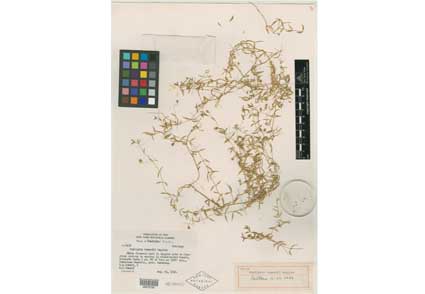Abstract
Molecular analyses have shown that Stellaria is a polyphyletic genus and several species are closely related to other genera of Caryophyllaceae. Among the excluded taxa, a group of four species (S. antillana, S. howardii, S. minutifolia, and S. ovata) appear to be not included in the core of Stellaria and are possibly related to the genus Triplateia. Despite this molecular evidence, as well as the morphology of these four species, a formal proposal for a new taxon is still lacking. I here describe the genus Maguirellaria gen. nov., including Maguire’s Stellaria howardii and S. minutifolia. S. antillana and S. ovata, which display a very different morphology in comparison with Maguire’s species, were never considered in the same molecular study; therefore, I prefer to avoid a taxonomic decision for the moment.
References
Castillo, D.A. & García, R. (1997) Ejemplares tipo en el herbario JBSD, Jardin Botanico Nacional “Dr. Rafael M. Moscoso” Santo Domingo, Republica Dominicana. Moscosoa 9: 26–61.
Chater, A.O. & Heywood, V.H. (1993) Stellaria L. In: Tutin, T.G., Burges, N.A., Chater, A.O., Edmondson, J.R., Moore, D.M., Valentine, D.H., Walters, S.M. & Webb, D.A. (eds.) Flora Europaea ed. 2, vol. 1. Cambridge University Press, Cambridge, Great Britain, pp. 161–164.
Dillenberger, M.S. & Kadereit, J.W. (2014) Maximum polyphyly: Multiple origins and delimitation with plesiomorphic characters require a new circumscription of Minuartia (Caryophyllaceae) + Electronic Supplement. Taxon 63: 64–88. https://doi.org/10.12705/631.5
Greenberg, A.K. & Donoghue, M.J. (2011) Molecular systematics and character evolution in Caryophyllaceae. Taxon 60 (6): 1637–1652. https://doi.org/10.1002/tax.606009
Hernández-Ledesma, P., Walter, G., Berendsohn, W.G., Borsch, T., von Mering, S., Akhani, H., Arias, S., Castañeda-Noa, I., Eggli, U., Eriksson, R., Flores-Olvera, H., Fuentes-Bazán, S., Kadereit, C., Klak, C., Korotkova, N., Nyffeler, R., Ocampo, G., Ochoterena, H., Oxelman, B., Rabeler, R.K., Sanchez, A., Schlumpberger, B.O. & Uotila, P. (2015) A taxonomic backbone for the global synthesis of species diversity in the angiosperm order Caryophyllales. Willdenowia 45: 281–383. https://doi.org/10.3372/wi.45.45301
Iamonico, D. (2013) Taxonomical and chorological study on the Central Mediterranean Basin endemic Arenaria bertolonii Fiori & Paol. (Caryophyllaceae). Plant Biostystems 147 (4): 923−930. https://doi.org/10.1080/11263504.2012.753956
Iamonico, D. (2014) Arenaria tenuifolia versus Arenaria hybrida (Caryophyllaceae): nomenclatural study and taxonomic implications. Phytotaxa 173 (3): 235–240. https://doi.org/10.11646/phytotaxa.236.1.6
Iamonico, D. (2015) Augustea (Polycarpaeae, Caryophyllaceae), a new genus from South America. Phytotaxa 236 (1): 71–78. https://doi.org/10.11646/phytotaxa.236.1.6
Iamonico, D. (2018) A conspectus of Silene sect. Lasiocalycinae (Caryophyllaceae). Phyton (Horn, Austria) 57 (1–2): 113–127. https://doi.org/10.12905/0380.phyton57-2018-0113
Iamonico, D. (2021) Engellaria (Caryophyllaceae), a new North American genus segregated from Stellaria. Acta Botanica Mexicana 128: e1846. https://doi.org/10.21829/abm128.2021.1846
Iamonico, D. & Domina, G. (2015) Nomenclatural notes on the Polycarpon tetraphyllum aggregate (Caryophyllaceae). Plant Biosystems 149 (4): 720–727. https://doi.org/10.1080/11263504.2015.1057260
IUCN (2016) The IUCN Red List of threatened species. Available from: http://www.iucnredlist.org/ (accessed: 17 May 2023)
Liogier, A.H. (1982) La flora de la Española, vol. 2. Universidad Central de Este, San Pedro de Macoris, Dominican Republic, 420 pp.
Maguire, B. (1948) Plant Explorations in Guiana in 1944, Chiefly to the Tafelberg and the Kaieteur Plateau-VI. Bulletin of the Torrey Botanical Club 75: 633−671. https://doi.org/10.2307/2482346
Maguire, B. (1958) Two Dominican Stellarias. Brittonia 10 (1): 32. https://doi.org/10.2307/2804691
Miller, C.H. & West, J.G. (2012) A revisión of the genus J.G. (Caryophyllaceae) in Australia. Journal of the Adelaide Botanic Garden 25: 27−54.
Morton, J.K. (2005) Stellaria L. In: Flora of North America Editorial Committee (eds.) Flora of North America North of Mexico, vol. 5. Oxford University Press, New York & Oxford, pp. 96–114.
Schilling, E.E., Floden, A.J., Weakley, A.S., Winder, C. & Small, R.L. (2022) Molecular barcoding reveals unexpected diversity in eastern North American stitchworts (Caryophyllaceae). Botanical Journal of the Linnean Society 200 (1): 75–84. https://doi.org/10.1093/botlinnean/boac001
Sharples, M.T. & Tripp, E.A. (2019) Phylogenetic relationships within and delimitation of the cosmopolitan flowering plant genus Stellaria L. (Caryophyllaceae): core stars and fallen stars. Systematic Botany 44 (4): 857–876. https://doi.org/10.1600/036364419X15710776741440
Shilong, C. & Rabeler, R.K. (2001) Stellaria. In: Wu, C.Y., Raven, P.H. & Hong, D.Y. (eds.) Flora of China, vol. 6. Science Press and Missouri Botanical Garden Press, Beijing, St. Louis pp. 11–29.
Thiers, B. (2023) [continuously update] Index Herbariorum: A global directory of public herbaria and associated staff. New York Botanical Garden’s Virtual Herbarium. Available from: http://sweetgum.nybg.org/ih/ (accessed: 17 May 2023).
Tikhomirov, V.N. (2016) (2427) Proposal to conserve the name Stellaria (Caryophyllaceae) with a conserved type. Taxon 65 (2): 389–390. https://doi.org/10.12705/652.21
Turland, N.J., Wiersema, J.H., Barrie, F.R., Greuter, W., Hawksworth, D.L., Herendeen, P.S., Knapp, S., Kusber, W.-H., Li, D.-Z., Marhold, K., May, T.W., McNeill, J., Monro, A.M., Prado, J., Price, M.J. & Smith, G.F. (eds.) (2018) International Code of Nomenclature for algae, fungi, and plants (Shenzhen Code). adopted by the Nineteenth International Botanical Congress, Shenzhen, China, July 2017. Regnum Vegetabile 159. Koeltz Botanical Books, Glashütten, 254 pp. https://doi.org/10.12705/Code.2018


